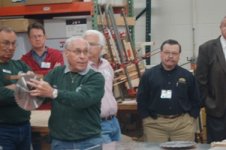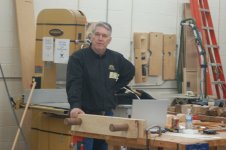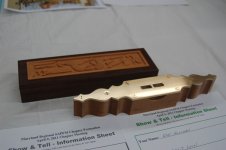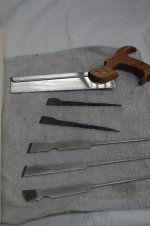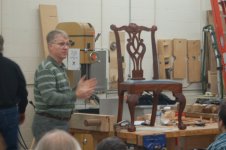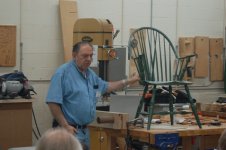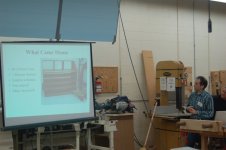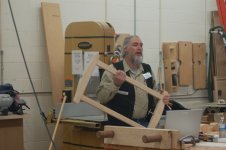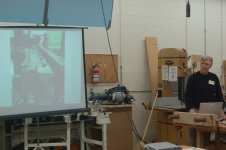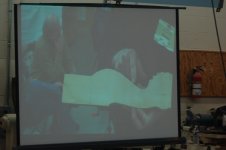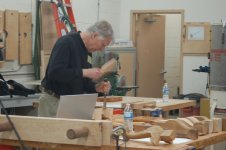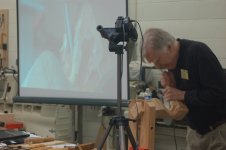Mark Maleski
Administrator
The Chesapeake chapter held our inaugural meeting yesterday, 9 April 2011, at Woodworkers Club in Rockville, MD. Over 40 people attended, including about a dozen non-members (8 of whom chose to join during the meeting). We had members from MD, VA, PA, DE, and NJ, and had 2 members of the Executive Council in attendance: Bob Mustain (President) and Don Williams (Outreach Committee). Bert Bleckwenn organized this first meeting and led/facilitated the presentations. Our agenda was divided into four areas: (1) socializing (I got to do too little of this), (2) chapter business, (3) show and tell, and (4) our featured presentation from Kaare Loftheim, Journeyman Cabinetmaker from Colonial Williamsburg. We also ran a silent auction tool sale throughout the meeting.
Bert kicked off the meeting with a discussion of chapter business. During this portion of the meeting we:
- Agreed on chapter name. We are now the Chesapeake chapter, and are intended to primarily serve members from the geography between the Delaware River Valley and Virginia chapters (though any SAPFM member will be welcomed enthusiastically at any chapter meeting).
- Adopted the chapter charter.
- Elected chapter leads: Bert Bleckwenn (President, responsible for setting direction, oversight, and coordinating with National), Fred Walker (Coordinator, sets direction and agenda for chapter meetings), and Mark Maleski (Secretary/Treasurer, including chapter communications).
- Discussed preferred time/location for our next full chapter meeting. Chapter meetings will be at least 2x per year (spring and fall), so our next full chapter meeting is being tentatively planned for September or October 2011. In the spirit of moving locations to equalize travel requirements, we'll investigate locations in the northern area of Maryland or near Harrisburg, PA for the next meeting.
- Discussed options for smaller/more focused gatherings throughout the year, including Road Trips. As Senior Furniture Conservator at the Smithsonian Institute's Center for Materials Research and Education, Don Williams suggested he could likely organize a tour of the facility in Suitland Maryland to learn about the conservation techniques employed on some of our civilization's most important and most rare furnishings. As evidence that Don is not your typical woodworker, he was heard to say the following later in the day: "I only build stuff to get to the finishing!" No date has been set for this Chesapeake chapter Road Trip, though Don was investigating dates in June (weekdays only).
- Other suggestions for Road Trips: Winterthur (current exhibition on Southeastern PA Furniture 1725-1850), Baltimore Museum of Art (current exhibition on Frederick & Baltimore Furniture), Philly Museum of Art Warehouse (their conservator is a former student of Don's), and the State Department (coordination needed, and also must be done on a weekday).
- We also discussed the concept of Special Interest Groups (focused on tools, techniques, skills enhancement) and Mentorship Groups (small, weekly gatherings providing opportunity for senior SAPFM members to share their expertise with more junior members). Don and Bob emphasized the Executive Committee's interest in fostering mentorship as an investment in the next generation of period furniture makers.
Bert kicked off the meeting with a discussion of chapter business. During this portion of the meeting we:
- Agreed on chapter name. We are now the Chesapeake chapter, and are intended to primarily serve members from the geography between the Delaware River Valley and Virginia chapters (though any SAPFM member will be welcomed enthusiastically at any chapter meeting).
- Adopted the chapter charter.
- Elected chapter leads: Bert Bleckwenn (President, responsible for setting direction, oversight, and coordinating with National), Fred Walker (Coordinator, sets direction and agenda for chapter meetings), and Mark Maleski (Secretary/Treasurer, including chapter communications).
- Discussed preferred time/location for our next full chapter meeting. Chapter meetings will be at least 2x per year (spring and fall), so our next full chapter meeting is being tentatively planned for September or October 2011. In the spirit of moving locations to equalize travel requirements, we'll investigate locations in the northern area of Maryland or near Harrisburg, PA for the next meeting.
- Discussed options for smaller/more focused gatherings throughout the year, including Road Trips. As Senior Furniture Conservator at the Smithsonian Institute's Center for Materials Research and Education, Don Williams suggested he could likely organize a tour of the facility in Suitland Maryland to learn about the conservation techniques employed on some of our civilization's most important and most rare furnishings. As evidence that Don is not your typical woodworker, he was heard to say the following later in the day: "I only build stuff to get to the finishing!" No date has been set for this Chesapeake chapter Road Trip, though Don was investigating dates in June (weekdays only).
- Other suggestions for Road Trips: Winterthur (current exhibition on Southeastern PA Furniture 1725-1850), Baltimore Museum of Art (current exhibition on Frederick & Baltimore Furniture), Philly Museum of Art Warehouse (their conservator is a former student of Don's), and the State Department (coordination needed, and also must be done on a weekday).
- We also discussed the concept of Special Interest Groups (focused on tools, techniques, skills enhancement) and Mentorship Groups (small, weekly gatherings providing opportunity for senior SAPFM members to share their expertise with more junior members). Don and Bob emphasized the Executive Committee's interest in fostering mentorship as an investment in the next generation of period furniture makers.

